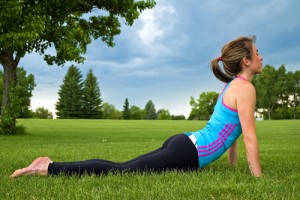Posted on April 14, 2016 by Jenny Cromack
Stretching has long been the advice of most fitness and health professionals. It is, in my opinion, important that the type of stretching is appropriate for your goals of stretching, so this blog looks at static vs dynamic stretching.
Many people will simply perform a static stretch that involves holding a position for a prolonged period of time as they are led to believe it reduces injury. Several reviews of research have actually shown that static stretching has no effect on the occurrence of exercise related musculo-skeletal injuries.
Static stretching is said to work through autogenic inhibition which is when receptors within the muscle-tendon complex detect tension and cause the muscle to relax. A prolonged hold of a stretch initiates this reflex. This would explain why static stretching has been shown to improve passive range of motion. Through the same mechanism however, static stretching has the potential to reduce power output, eccentric strength, and ultimately performance. Because of the relaxing effect of static stretching the elastic properties of the muscle are reduced.
So is static stretching beneficial? I would say that static stretching has its place when trying to improve the range of motion in a muscle that has severely restricted movement. This would tend to be in a rehabilitation setting where a recently injured limb has become restricted and its associated muscles are shortened.
Dynamic stretching is different in that it involves a controlled movement of muscles and joints through, and up to the limits of, their active range of movement. These movements are not jerky but done under control. The mechanism by which dynamic stretching works is through reciprocal inhibition. This is when one muscle contracts it causes the opposing muscle to relax. So by moving the limb actively through a range one muscle is working and the muscle being stretched is forced to relax. Because of the active movement blood flow and muscle temperature is also increased which has further beneficial effects on the active range of movement of the muscles. The muscle is not being forcefully push into passive limits of its range there is a reduced risk of reducing elastic properties which minimise reductions in performance elements. Dynamic stretching has actually been shown to improve power output. Therefore, in my opinion, dynamic stretching is an ideal addition to any warm up as long as it replicates the movements involved in your activity.
In conclusion if you are going to include stretching in you exercise warm up routines I would lean more towards including dynamic stretches that are similar to your working activities. They should move you through the same movements and only work into your active range. Whereas if you are recovering from injury and struggling with regaining full range in a joint or muscle passive stretching is a good starting point to achieve a near normal range before moving on to more dynamic work.


